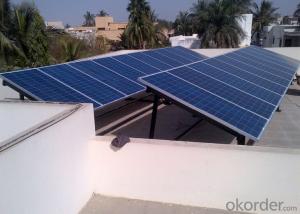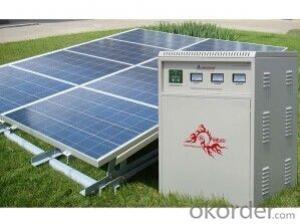Off grid Solar Pwer System PR-SAS500 With Battery Tank 400W
- Loading Port:
- Tianjin
- Payment Terms:
- TT OR LC
- Min Order Qty:
- 10 pc
- Supply Capability:
- 10000 pc/month
OKorder Service Pledge
OKorder Financial Service
You Might Also Like
Item specifice
Specifications
1.Supply 2 work modes: to save electricity bill or to supply long time power backup.
2. Supply battery tank,high integrated.
Daily use reference
TV 70W x 4 hours
Lighting 30W x 6 hours
Fan 50W x 6 hours
Laptop 60W x 2 hours
Total loading power: 210W
Total power consumption per day: 880Wh (0.88kWh/day)
AC solar power system consists of solar batteries, solar controller, battery, inverter components.
Used to solve rural or remote areas without electricity, such as highland, island, pastoral, villas, border posts and other military and civilian life electricity.
Warranty
CNBM Solar panel provides one of the most comprehensive module warranties in the industry:
· 10 years for product defects in materials and workmanship
· First 12 years for 90% of warranted minimum power
· Remaining 25 years for 80% of warranted minimum power
Certification
CNBM Solar panel strictly carries out the ISO 9001 quality control methodology and has implemented check points at every step of the production process to ensure our product performance durability and safety. The stringent quality control process has been confirmed by numerous independent agencies and LDK Solar modules earned IEC, TUV and UL certifications.
· IEC:IEC 61215, IEC 61730 (1&2), conformity to CE
· UL 1703 2002/03/15 Ed:3 Rev:2004/06/30
· ULC/ORD-C1703-01 Second Edition 2001/01/01
· UL and Canadian Standard for Safety Flat-Plate
· ISO 9001: 2008 Quality Management Systems
· CEC Listed: Modules are eligible for California Rebates
· PV Cycle: Voluntary module take back and recycling program
· MCS Certificate
FAQ
l Where can I buy your products?
You could find our products from dealers or contact our sales team directly. We will provide you with detailed services.
l How to contact us?
Contact details can be found from website www.okorder.com to contact us. We look forward to providing you with professional services.
l What is the application field of your products?
They can be used in the small photovoltaic (PV) grid power generation systems of family units as well as the commercial photovoltaic system such as BIPV, BAPV and etc.
l What kinds of modules do your inventers support?
Our inventers support most of mainstream components and modules in the market. Should you require more details, please do not hesitate to contact our technical personnel.
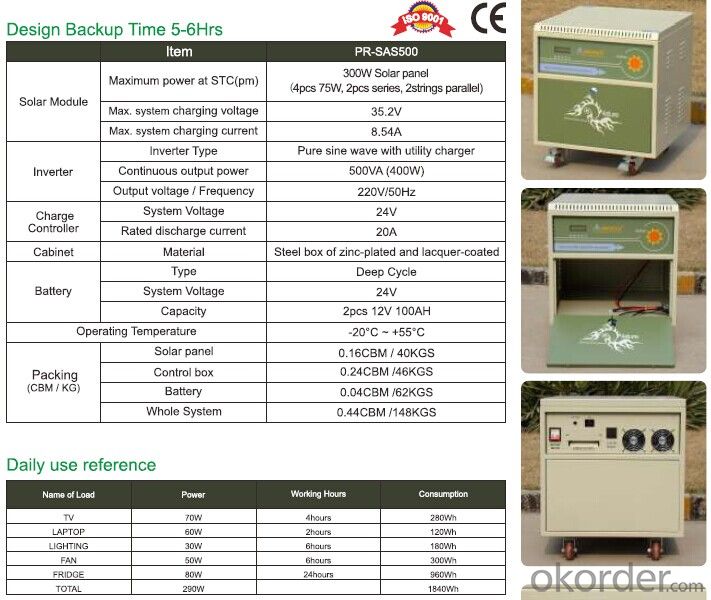

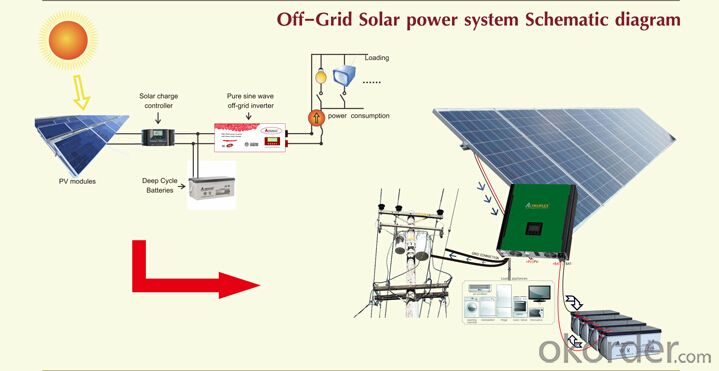
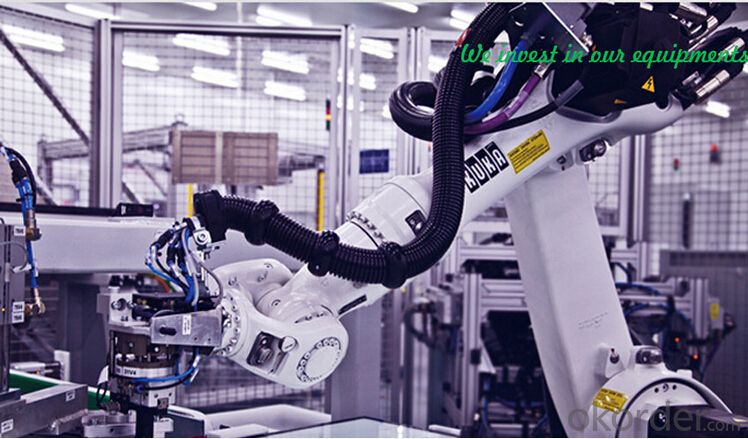


- Q:How do solar energy systems impact the demand for traditional energy sources?
- Solar energy systems have a significant impact on the demand for traditional energy sources. As more and more solar panels are installed and integrated into the power grid, the reliance on fossil fuels decreases. This is because solar energy systems generate electricity directly from sunlight, eliminating the need for traditional energy sources such as coal, oil, and natural gas. The increased adoption of solar energy systems reduces the demand for traditional energy sources in several ways. Firstly, solar power can be produced locally, reducing the need for long-distance transmission of electricity from power plants. This reduces transmission losses and the associated costs, making solar energy more economically viable. Secondly, solar energy systems generate electricity during daylight hours when demand is typically high, especially in residential and commercial settings. This reduces the strain on traditional energy sources during peak demand periods, which can help stabilize the power grid and prevent blackouts or shortages. Furthermore, the integration of solar energy systems into the power grid allows for excess electricity to be fed back into the grid. This surplus energy can be used by other consumers, reducing the overall demand for traditional energy sources. This concept, known as net metering, not only reduces the reliance on traditional energy sources but also incentivizes the adoption of solar energy systems. Overall, the widespread use of solar energy systems has a positive impact on the demand for traditional energy sources. It reduces the need for fossil fuels, promotes energy independence, and contributes to the global transition towards clean and renewable energy sources. However, it is important to note that complete replacement of traditional energy sources with solar energy is not feasible in all situations, and a balanced energy mix is still necessary to meet the diverse energy demands of society.
- Q:Can solar energy systems be used for powering wineries?
- Certainly, wineries can make use of solar energy systems to power their operations. Solar power is an eco-friendly and renewable energy source that can offer a consistent and dependable supply of electricity for winemaking activities. Various processes in wineries, including grape crushing, fermentation, cooling, bottling, and storage, demand a substantial amount of energy. On that note, by installing solar panels, wineries can produce their own electricity, reducing their dependence on fossil fuels and decreasing their carbon footprint. It is possible to install solar energy systems on winery buildings' rooftops or in nearby open spaces like vineyards. These systems consist of solar panels that convert sunlight into electricity using the photovoltaic effect. The generated electricity can be directly used to power winery operations or stored in batteries for later use, ensuring a constant power supply even during cloudy days or at night. One of the significant advantages of adopting solar energy in wineries is the potential for long-term cost savings. Although the initial installation cost of solar panels may be relatively high, the operational expenses are considerably lower compared to conventional energy sources. Once the solar system is in place, wineries can enjoy reduced or even eliminated electricity bills, resulting in substantial savings over the system's lifespan. Furthermore, solar energy systems for wineries can be customized to meet specific energy requirements. By conducting a thorough energy assessment, wineries can determine their electricity demand and tailor the solar system accordingly. This allows wineries to have a personalized solution that fulfills their energy needs and ensures optimal performance. Besides the financial and environmental benefits, employing solar energy in wineries can also enhance their brand image and reputation. With consumers becoming increasingly conscious of sustainability and environmentally friendly practices, wineries that demonstrate a commitment to clean energy can attract eco-conscious customers. As a result, this can lead to increased sales and customer loyalty. In conclusion, solar energy systems present a practical and efficient option for powering wineries. By harnessing the sun's power, wineries can reduce their reliance on conventional energy sources, cut down on operating costs, and contribute to a greener and more sustainable future.
- Q:Can solar energy systems be used in all climates?
- Solar energy systems can be used in all climates to some extent, but their efficiency and effectiveness may vary. While solar panels can generate electricity even in colder climates, they may produce less energy compared to sunnier regions. Additionally, extreme weather conditions like heavy snowfall or frequent cloud cover can temporarily reduce solar energy production. However, advancements in solar technology, such as the use of dual-axis tracking systems, can help optimize energy generation in different climates.
- Q:Can solar energy systems be used in powering schools or educational institutions?
- Yes, solar energy systems can definitely be used to power schools or educational institutions. Installing solar panels on the rooftops of these buildings can generate clean and renewable electricity, reducing their reliance on traditional fossil fuel sources. This not only helps to reduce greenhouse gas emissions and combat climate change but also saves money on energy bills in the long run. Moreover, educational institutions can serve as role models for sustainable practices by demonstrating the use of solar energy and teaching students about the importance of renewable energy sources. Additionally, solar power systems can be integrated into the curriculum, allowing students to learn about solar energy and its applications in real-life settings. Overall, incorporating solar energy systems into schools and educational institutions can have multiple benefits, both in terms of environmental sustainability and educational opportunities.
- Q:How do solar energy systems impact national energy policy?
- Solar energy systems have a significant impact on national energy policy as they promote the diversification of the energy mix, reduce dependence on fossil fuels, and contribute to the overall goal of achieving clean and sustainable energy sources. Governments often incentivize the adoption of solar technologies through various policies, such as tax credits and feed-in tariffs, to accelerate their deployment and achieve renewable energy targets. Additionally, the integration of solar energy systems into the national grid can enhance energy security, create jobs, and stimulate economic growth in the renewable energy sector. Overall, solar energy systems play a crucial role in shaping national energy policies towards a greener and more sustainable future.
- Q:Can solar energy systems be used in powering agricultural irrigation systems?
- Certainly, agricultural irrigation systems can be powered by solar energy systems. As a matter of fact, solar energy is gaining popularity in the agricultural industry due to its numerous advantages. To begin with, solar energy is a clean and renewable source of power, which aids in reducing greenhouse gas emissions and combating climate change. This is especially crucial in agriculture, where conventional power sources like diesel generators contribute to air pollution. Furthermore, solar energy systems are simple to install and maintain. They typically consist of solar panels, an inverter, and a battery storage system. These components can be installed on rooftops, open fields, or even on solar trackers to maximize exposure to sunlight. Once installed, solar energy systems require minimal upkeep, resulting in reduced operational expenses for farmers. Moreover, solar energy systems are particularly well-suited for powering agricultural irrigation systems. Irrigation systems often require a constant and dependable energy source to pump water from wells, rivers, or reservoirs to the fields. Solar energy can fulfill this need for consistent power supply, particularly in sunny regions with high irrigation demands. Additionally, solar energy systems can be combined with energy storage solutions like batteries. This enables farmers to store surplus energy generated during the day and utilize it during periods of low sunlight or at night, ensuring uninterrupted power supply for irrigation systems. Furthermore, solar-powered irrigation systems can prove to be more cost-effective in the long run. Although the initial investment for installing solar panels and associated equipment may be higher compared to traditional power sources, the operating costs are significantly lower. Once the solar energy system is in place, farmers can benefit from free energy from the sun, reducing reliance on expensive fossil fuels or grid electricity. To sum up, solar energy systems are a feasible and sustainable choice for powering agricultural irrigation systems. They offer environmental advantages, are easy to install and maintain, and can provide a reliable and cost-effective energy supply for farmers.
- Q:What is the impact of snow or ice on solar energy system performance?
- Snow or ice can significantly impact the performance of a solar energy system. When snow or ice covers the solar panels, it prevents sunlight from reaching the photovoltaic cells, reducing the system's energy production. Additionally, the weight of snow or ice on the panels can cause structural damage or lead to misalignment, further reducing the system's efficiency. Proper maintenance, such as snow removal or tilt adjustments, is crucial to ensure optimal performance during winter months.
- Q:Are there any tax credits available for installing a solar energy system?
- Yes, there are tax credits available for installing a solar energy system. The federal government offers a Solar Investment Tax Credit (ITC) which allows homeowners and businesses to deduct a percentage of the cost of installing a solar energy system from their federal taxes. As of 2021, the ITC offers a 26% tax credit for systems installed through the end of 2022. However, it is important to note that the tax credit will decrease to 22% in 2023 and will only apply to commercial installations. Additionally, some states also offer their own tax incentives for solar energy systems, such as tax credits, rebates, or exemptions. It is recommended to check with your state or local government to determine if there are any specific tax credits available in your area.
- Q:What is the role of solar energy systems in reducing energy inequality?
- Solar energy systems play a crucial role in reducing energy inequality by providing access to affordable and sustainable energy sources for communities that are traditionally underserved or lack reliable access to electricity. One of the main advantages of solar energy systems is their scalability, which makes them suitable for both large-scale installations and small-scale community-based projects. This flexibility allows solar energy systems to be deployed in rural areas, where the grid infrastructure may be nonexistent or unreliable. By harnessing the power of the sun, these systems can provide electricity to homes, schools, and healthcare facilities, improving the quality of life for people in these communities and bridging the energy gap. Furthermore, solar energy systems can be installed on rooftops, reducing the need for additional land and minimizing the environmental impact. This is particularly important in urban areas where space is limited and traditional energy sources, such as coal or gas, may be more polluting and harmful to human health. Solar energy systems can help reduce air pollution and associated health issues, creating a cleaner and healthier environment for all. Another key aspect of solar energy systems is their potential for decentralized energy production. Instead of relying solely on large power plants located far away from communities, solar energy systems allow for distributed generation, meaning electricity can be produced and consumed locally. This decentralization empowers communities to take control of their energy production, reducing their dependence on centralized grids and often volatile energy prices. Solar energy systems also have the potential to create economic opportunities and reduce energy costs for marginalized communities. By investing in solar installations, communities can generate income through the sale of excess energy back to the grid, creating local jobs and promoting economic development. Additionally, solar energy systems can help lower energy bills for households, freeing up financial resources that can be allocated to other essential needs. In summary, solar energy systems play a critical role in reducing energy inequality by providing equitable access to affordable, sustainable, and clean energy sources. By addressing energy poverty and promoting self-sufficiency, solar energy systems contribute to a more inclusive and sustainable future for all.
- Q:Can solar energy systems be used for powering electric boat charging stations?
- Yes, solar energy systems can indeed be used for powering electric boat charging stations. Solar panels capture sunlight and convert it into electricity, which can then be used to charge the batteries of electric boats. By installing solar panels on the roofs or nearby areas of the charging stations, the energy produced can directly power the charging infrastructure. This not only makes the charging stations environmentally friendly by utilizing renewable energy, but it also reduces dependence on the power grid, making them more independent and sustainable. Additionally, using solar energy for electric boat charging stations can also help reduce operating costs in the long run, as the electricity generated from solar panels is free once the initial installation costs are covered.
1. Manufacturer Overview |
|
|---|---|
| Location | |
| Year Established | |
| Annual Output Value | |
| Main Markets | |
| Company Certifications | |
2. Manufacturer Certificates |
|
|---|---|
| a) Certification Name | |
| Range | |
| Reference | |
| Validity Period | |
3. Manufacturer Capability |
|
|---|---|
| a)Trade Capacity | |
| Nearest Port | |
| Export Percentage | |
| No.of Employees in Trade Department | |
| Language Spoken: | |
| b)Factory Information | |
| Factory Size: | |
| No. of Production Lines | |
| Contract Manufacturing | |
| Product Price Range | |
Send your message to us
Off grid Solar Pwer System PR-SAS500 With Battery Tank 400W
- Loading Port:
- Tianjin
- Payment Terms:
- TT OR LC
- Min Order Qty:
- 10 pc
- Supply Capability:
- 10000 pc/month
OKorder Service Pledge
OKorder Financial Service
Similar products
New products
Hot products
Related keywords
